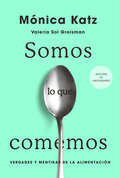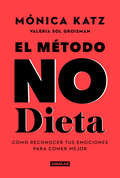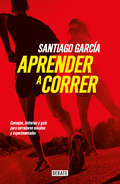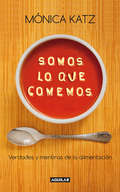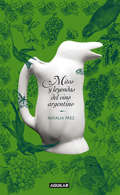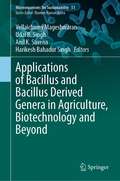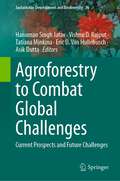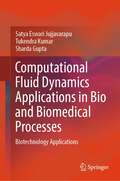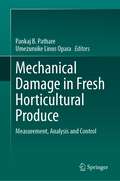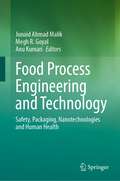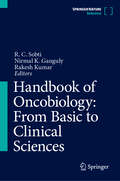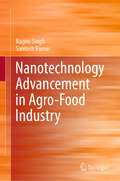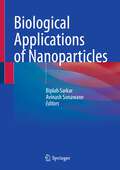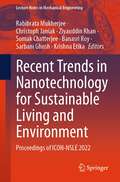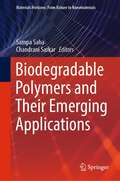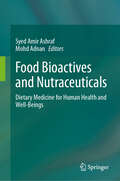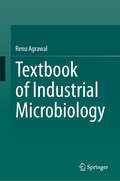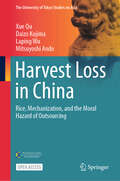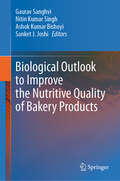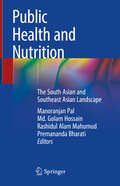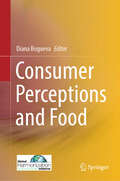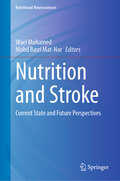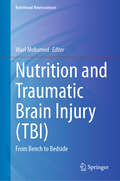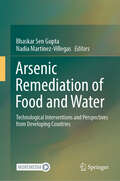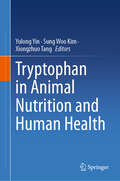- Table View
- List View
Somos lo que comemos: Verdades y mentiras de la alimentación
by Mónica KatzEn esta edición décimo aniversario, revisada y actualizada, Mónica Katz y Valeria Sol Groisman nos introducen en el apasionante mundo de la alimentación y descomponen en todas sus facetas el prisma de esa actividad humana. En esta edición aniversario, revisada y actualizada, Mónica Katz y Valeria Sol Groisman nos introducen en el apasionante mundo de la alimentación y describen todas las facetas de esta actividad humana. ¿Por qué nos gustan ciertas comidas y rechazamos otras? ¿Qué función cumplen los sentidos? ¿Cómo utiliza la industria esos conocimientos? ¿Qué responsabilidad tiene el Estado en el control y la producción de los alimentos? ¿Cuáles son beneficiosos para nuestro organismo, cuánto debemos consumir y cómo tenemos que hacerlo para lograr disfrutar de la comida, sin recurrir a ninguna dieta? ¿Alcanza la ley de etiquetado? Este libro es fundamental porque comer es imprescindible para vivir. Pero también porque lo hacemos para obtener placer, por aburrimiento, para calmarnos, para reunirnos con amigos y familia, para celebrar, para seducir. Y vivimos rodeados de estímulos que incitan a comer: programas de televisión, publicidades, restaurantes, bares, kioscos y comercios con góndolas rebosantes de alimentos y bebidas al alcance de nuestra mano. Como la industria ha logrado producir alimentos a gran escala, procesados y especialmente diseñados para el consumo, no siempre sabemos qué es lo que en verdad consumimos cada vez que comemos.
El método No Dieta: Cómo reconocer tus emociones para comer mejor
by Mónica Katz Valeria Sol GroismanEl manejo de las emociones y de otros obstáculos son fundamentales a la hora de emprender una dieta porque de eso depende que podamos encarar un cambio en nuestra forma de alimentarnos. A diez años de No Dieta. Puentes entre la alimentación y el placer, Mónica Katz junto con su hija Valeria Sol Groisman continúa profundizando su revolucionario trabajo sobre la alimentación, que indaga no solo en lo que comemos sino también en las razones para realizar una dieta. Esos mismos motivos pueden ser las causas para abandonar un régimen. Las estrategias para perder peso, casi todas restrictivas, fracasan porque se concentran en la comida. En este libro, las autoras ponen el foco en esos otros factores que hacen que una dieta no funcione: las emociones, los fanatismos, la información de los medios de comunicación y las redes sociales, y los mitos alimentarios. "Estoy cansada -dice Katz- de ver desfilar pacientes y conocidos que han invertido años, esfuerzo, batallas familiares y dinero en dietas de moda, y están más gordos que nunca. [...] Por más que reformulemos los alimentos, que regulemos su calidad, sus porciones, su publicidad, por más de que mejoremos el acceso a la actividad física y al juego como derecho de grandes y chicos, si no enseñamos que las emociones son necesarias (por eso mismo no deberíamos taparlas con comida), seguiremos sin hallar soluciones". El método No Dieta nos ofrece las herramientas para escuchar nuestras emociones, modificar nuestros hábitos y tener una alimentación saludable sin fracasar en el intento.
Aprender a correr: Consejos, historias y guía para corredores novatos y experimentados
by Santiago GarcíaAprender a correr es el libro más completo sobre el running escrito en Argentina. Es un manual para principiantes, pero también para corredores experimentados. Combina esos tips básicos que muchos no conocen u olvidan con consejos de expertos de todas las áreas. Como muchos corredores del mundo, Santiago García descubrió la pasión por el running a una edad a la que los atletas profesionales se retiran pero los amateurs comienzan. Y como para tantos otros, esta disciplina significó una segunda oportunidad en su vida, a la que le dedicó desde entonces toda su energía y conocimiento. De eso trata este libro: de entender que cualquiera puede correr, y que nunca es tarde para arrancar. Y de cómo hacerlo bien, con ganas, mirando siempre para adelante. Después de contar su experiencia en Correr para vivir, vivir para correr, García abre aquí el juego a otros corredores y otras historias. Todo lo que le importa al corredor está acá. Prevenir lesiones. Las diferentes formas de entrenamiento. La dieta y el descanso. La primera carrera. Correr para conocer la ciudad, el país, todo el planeta. Aprender a correr es el volumen más completo sobre el running escrito en Argentina. El mejor manual posible para principiantes, pero también para corredores experimentados. La combinación perfecta de los tips más básicos con los consejos de los especialistas, que comparten sus secretos para que hagamos del running la experiencia más importante y satisfactoria de nuestras vidas.
Somos lo que comemos: Verdades y mentiras de la alimientación
by Mónica KatzMónica Katz nos introduce en el apasionante mundo de la alimentación. ¿Qué es lo que en verdad consumimos cada vez que comemos? Comer es imprescindible para vivir, pero también comemos para obtener placer, por aburrimiento, para calmarnos, para no pensar, para reunirnos con amigos y familia, para celebrar, para seducir. Y vivimos rodeados de estímulos que incitan a comer: programas de TV, publicidades, restaurantes, bares, kioscos y comercios con góndolas rebosantes de alimentos y bebidas, al alcance de nuestra mano. En ese sentido, la industria ha logrado producir alimentos a gran escala, procesados y especialmente diseñados para el consumo, a tal punto que no siempre sabemos qué es lo que en verdad consumimos cada vez que comemos. Mónica Katz nos introduce en el apasionante mundo de la alimentación y descompone en todas sus facetas el prisma de esa actividad humana. ¿Por qué nos gustan tanto ciertas comidas y por qué rechazamos otras? ¿Qué función cumplen los sentidos en la selección y el consumo? ¿Cómo utiliza la industria esos conocimientos? ¿Qué responsabilidad tiene el Estado en el control y la producción de alimentos? ¿Cuáles son beneficiosos para nuestro organismo, cuánto debemos consumir y cómo tenemos que hacerlo para lograr, sin recurrir a ninguna dieta, disfrutar de la comida y ganar en salud?
Mitos y leyendas del vino argentino
by Natalia PáezFruto de una investigación minuciosa, los relatos reunidos en Mitos y leyendas del vino argentino conforman una historia no oficial de nuestra bebida nacional. Un jinete fantasma recorre las fincas donde se plantaron las primeras cepas de Malbec; un oscuro bodeguero con fama de vampiro aterra a sus vecinos; una bodega está habitada por espectros que hacen oír sus voces. Seres fantásticos, míticos, tan argentinos como la jarra en forma de pingüino, curanderas de tormentas, trovadores del vino, conviven en este libro con San Martín, Sarmiento y Eva Perón. Realidad y leyenda se mezclan en las narraciones de los descendientes de aquellos inmigrantes emprendedores que fundaron una de las actividades económicas más prósperas del país, entre ellos, el mejor enólogo argentino del siglo XX. Además de esas narraciones, Natalia Páez nos habla del vino en la poesía, en el tango y en el fútbol. Y describe con lujo de detalles las dos fiestas de la vendimia que se celebran todos los años en Mendoza.
Applications of Bacillus and Bacillus Derived Genera in Agriculture, Biotechnology and Beyond (Microorganisms for Sustainability #51)
by Harikesh Bahadur Singh Udai B. Singh Anil K. Saxena Vellaichamy MageshwaranThis edited volume provides a comprehensive view of the recent developments on Bacillus and their application in agriculture and allied sectors in a global scenario. Research articles sharing a consolidated state-of-the-art development in this area are solicited for this book. This book is a complete package covering all spheres of diversity and taxonomy, nutrient supplementation, biotic and abiotic stress management, biofilm and endophytic colonization, commercialization and regulatory mechanisms, etc. Descriptions of cutting-edge techniques and novel approaches on Bacillus research is also covered. A part of the book concentrates on the biotic and abiotic stress management in several important crops. It contains 11 contributory chapters from eminent experts in the field of life sciences specially microbiology, plant pathology and biotechnology working on different aspects of Bacilli and their application in agriculture and allied sectors. This book is useful for Graduate, Post-graduate students, research scholars, and post doctorate scholars of plant science, plant microbiology, soil microbiology and plant pathology discipline researchers, academicians, industrialists, policy makers.
Agroforestry to Combat Global Challenges: Current Prospects and Future Challenges (Sustainable Development and Biodiversity #36)
by Eric D. Van Hullebusch Vishnu D. Rajput Hanuman Singh Jatav Tatiana Minkina Asik DuttaThis edited book brings out comprehensive insights on agro-forestry systems to cope up climate change globally. The main essence of this book is to unfurl the positive sides of agri-silvipastoral system to reduce greenhouse gases (GHGs) and temperature. Agro-forestry can be defined as the farming practice combining field crops, perennial trees and livestock. The impact of agro-forestry on ecology is implacable which is thoroughly discussed under different heads in this book. In addition, the book is bundle of different novel sections including tables, graphical representation, and figures showcasing the bright side of agro-forestry system. Furthermore, trees which are important component of boosting socio-economic conditions, especially for the indigenous populations have also been discussed meticulously. Hence, all together this book deciphers an account of agro-forestry practices in society and environment along with the major pros- and cons- of the system. Undoubtedly, this information could enrich the scholarly knowledge for graduate research fellows, teachers, scientists, researchers, and environmentalists in gaining multifaceted information of agro-forestry system in both ecological and economical aspects. Different research highlights will be helpful for the policy makers to implement this novel practice in intensive production systems and harness the maximum benefits out of this.
Computational Fluid Dynamics Applications in Bio and Biomedical Processes: Biotechnology Applications
by Satya Eswari Jujjavarapu Tukendra Kumar Sharda GuptaThis book covers emerging areas in novel design and their hydrodynamic properties relevant to bioreactors, environmental system, electrochemical systems, food processing and biomedical engineering. This book uses an interdisciplinary approach to provide a comprehensive prospective simulation modeling and hydrodynamic study in advanced biotechnological process and includes reviews of the most recent state of art in modeling and simulation of flows in biological process, such as CFD. Written by internationally recognized researchers in the field, each chapter provides a strong introductory section that is useful to both readers currently in the field and readers interested in learning more about these areas.
Mechanical Damage in Fresh Horticultural Produce: Measurement, Analysis and Control
by Pankaj B. Pathare Umezuruike Linus OparaThis book includes the impact, compression, vibration studies, and destructive and nondestructive techniques for bruise measurement. It is essential to detect bruises in the early stages of their formation and conduct a quantitative analysis of the degree of bruising, to ensure the accurate grading of bruised fruits and vegetables and reduce unnecessary economic losses. Bruise damage occurring between the point of harvest and consumption contributes the most to the decrease in fruit quality, reducing the market value and ultimately leading to significant reductions in potential revenue. SDG 12.3 aims to “by 2030, halve per capita global food waste at the retail and consumer levels and reduce food losses along production and supply chains, including post-harvest losses.” This book presents recent technological developments in bruise measurement, detection, and analysis of fresh horticultural produce. Given the rising demand for rapid and accurate methods of quality measurement in the horticultural produce industry, this book covers destructive and nondestructive techniques for bruise measurement. Selected applications of different nondestructive methods for various fresh produce commodities are also included. This book will interest graduate and undergraduate students, researchers, academics and engineers working in different aspects of the mechanical damage affected by postharvest handling practices, professionals working in the governments, and other authorities related to fresh horticultural produce quality, regulations, and safety.
Food Process Engineering and Technology: Safety, Packaging, Nanotechnologies and Human Health
by Megh R. Goyal Junaid Ahmad Malik Anu KumariThis book focuses on novel technologies related to food processing technology and engineering. It also focuses on food safety, quality and management, the scope of the Internet of Things (IoT) in food processing and its management, bioengineering tools for crop improvement in agriculture, recent innovations in food packaging, nanotechnology in food processing, and the nutritional health benefits of food. 3D printed food, an interesting and increasingly popular concept among the public today, is a meal prepared through an automated additive process using 3D food printers. This book is a ready reference for food researchers, students, and industry professionals. The book updates the current scenario of food processing technology and engineering for readers from agriculture and its allied fields including students and researchers of food science and technology, dairy science and technology, packaging industry, people working in food safety organisations, and researchers in the field of nanotechnology.
Handbook of Oncobiology: From Basic to Clinical Sciences
by Nirmal K. Ganguly Rakesh Kumar R. C. SobtiThis Handbook on cancer biology comprehensively reviews the current status of the oncobiology of major cancer types, cancer detection and treatment strategies, principles and processes of cancer drug development, and nanomedicine and other emerging cancer medicine applications to cancer diagnosis and treatment. The book also provides practical and implementable nutritional guidance in cancer prevention, treatment, and quality of life for cancer survivors. It discusses pharmacogenetics strategies for predicting cancer prognosis and treatment exposure, response, and toxicity. Further, it presents bioinformatics approaches for predicting anti-cancer drugs and drug combinations based on the multi-omic data, including transcriptomics, toxicogenomics, functional genomics, and biological networks. The Handbook also examines major factors and pathways that regulate cancer stem cells development and discusses potential targeted therapy for cancer stem cells. The book explores the application of the CRISPR/Cas9-based gene-editing technique in basic cancer research, diagnosis, and treatment of cancer. This Handbook is an invaluable source for oncologists, researchers, public health specialists, epidemiologists, and policy makers.
Nanotechnology Advancement in Agro-Food Industry
by Santosh Kumar Ragini SinghThis book provides a comprehensive insight into the growth of nanotechnology in the agri-food industry. Currently, nanotechnology serves as the most promising means to resolve the issues encountered in the food sector, as it enables the production of high-quality food with exceptional characteristics such as extended shelf life, flavor, freshness, and high nutritional content. This book focuses on the applications of nanotechnology in various fields such as smart packaging, processing, and preservation of food. It also emphasizes the role of nanomaterials in strategic design of nutraceuticals and functional foods. Along with providing an overview of the innovations and application, this book also describes future perspectives, and offers insights to ensure consumer confidence in terms of safe use. In this context the application of nanomaterials as nanosensors is additional covered. The book provides readers with a deep knowledge regarding nanomaterials-based biosensors (colorimetric, electrochemical, fiber-based) for detection of pathogens in contaminated food. Factors affecting risk assessment regulations and safety concerns regarding the use of nanomaterials in food industry have also been discussed in detail. Given its scope, this book appeals to a wider readership, especially for researchers and students who work in food agronomy and nanomaterials and nanotechnology related fields.
Biological Applications of Nanoparticles
by Biplab Sarkar Avinash SonawaneThis textbook for graduate and postgraduate students provides comprehensive applications of nanoparticles in medicine, agriculture, and environmental sciences. The initial chapter covers basic topics related to types, synthesis, structure, and properties of various nanoparticles. It further discusses the wide range of applications of nanoparticles in medicine, agriculture, and the environment. The book presents nano-electronic biosensors that are used to diagnose and monitor the progression of human diseases. It summarizes the opportunities and challenges of nanotechnology in the agriculture and food sector highlighting the scientific, technical, regulatory, safety, and societal impacts. Additionally, it illustrates the applications of nanotechnology in the field of aquaculture medicine, bioinformatics and food technology. The textbook examines the development and administration of nano-medicines , their applications, advantages, and limitations for the treatment and prophylaxis of a broad range of diseases. Lastly, the textbook explores the recent advances in the field of nanobusiness and nanotechnology issues in intellectual property management( IPR).
Recent Trends in Nanotechnology for Sustainable Living and Environment: Proceedings of ICON-NSLE 2022 (Lecture Notes in Mechanical Engineering)
by Rabibrata Mukherjee Christoph Janiak Ziyauddin Khan Somak Chatterjee Banasri Roy Sarbani Ghosh Krishna EtikaThis book presents the select proceedings of International Conference on Nanotechnology for Sustainable Living and Environment (ICON-NSLE 2022). It covers the latest trends in nanotechnology and its applications in various sectors such as energy, environment, food technology, and biomedicine. Various topics covered in this book are nanomaterial preparation and characterization, nanobiotechnology, nanodevices, waste to wealth, pollution abatement, renewable energy, advanced materials, sensors and portable electronics, biomedical applications, food preservation, etc. This book is useful for researchers and professionals working in the area of nanotechnology and environment sustainability.
Biodegradable Polymers and Their Emerging Applications (Materials Horizons: From Nature to Nanomaterials)
by Sampa Saha Chandrani SarkarBio-degradable polymers are rapidly emerging as a sustainable alternative to traditional petroleum-based plastics and polymers. However, the synthesis and processing of such polymers present unique challenges and opportunities. In this comprehensive volume, Dr. Saha and her team provide an in-depth exploration of the synthesis and processing of bio-degradable polymers and their emerging applications in various sectors from drug delivery to food packaging. Covering a wide range of topics, including synthesis, modification, processing techniques, and few of their advanced applications in emerging areas, this book provides a comprehensive overview of the field. The authors also delve into cutting-edge research on the synthesis, properties and applications of bio-degradable polymers in various fields, such as agricultural, food preservation, biomedical arena, energy storage and other advanced application areas. This volume is an essential resource for scientists, engineers, and policymakers interested in the future of sustainable materials. Whether you are a researcher looking to expand your knowledge of biodegradable polymer synthesis and processing or a policymaker interested in the potential of biodegradable polymers to reduce our reliance on fossil fuels, this book is an invaluable guide to the field.
Food Bioactives and Nutraceuticals: Dietary Medicine for Human Health and Well-Beings
by Mohd Adnan Syed Amir AshrafThis book examines nutraceuticals derived from plant, animal, or microbial sources, and presenting significant opportunities for food scientists and industry professionals to develop innovative foods or food components that address future human wellness and well-being requirements. These nutraceuticals can be specifically identified as antioxidants, dietary fiber, prebiotics, polyunsaturated fatty acids, probiotics, vitamins, polyphenols, and spices. The book also intends to consolidate current research and reviews on bioactive components inherent in traditional foods, highlighting their nutraceutical significance for promoting a healthy lifestyle. Moreover, it elaborates on the potential therapeutic applications of food bioactives as next-generation nutraceuticals sourced from novel origins. Emphasis is placed on various aspects of food bioactive compounds, exploring their prospective roles in the formulation of nutraceuticals aimed at enhancing human health and wellness, while also evaluating their potential in the management and prevention of metabolic disorders. Furthermore, the volume acknowledges the clinical implications of nutraceuticals, including their prospective applications within the food and pharmaceutical industries.
Textbook of Industrial Microbiology
by Renu AgrawalTextbook of Industrial Microbiology is a groundbreaking book encompassing the entire spectrum of industrial microbiology, filling a significant void in the field. From tracing its historical roots to exploring primary and secondary metabolites, down to downstream processing and product recovery, this book offers a cohesive narrative previously unavailable in a single resource. The meticulously structured chapters discuss the systematic journey of metabolites, covering the screening of microorganisms, preservation techniques, fermentation media, fermenters, and the significance of industrially vital secondary metabolites. It provides insights for industrialists, elucidating crucial process parameters essential for comprehending and optimizing microbial processes. This textbook serves as a great resource for undergraduate, and postgraduate students, researchers, industrialists, and technologists
Harvest Loss in China: Rice, Mechanization, and the Moral Hazard of Outsourcing (The University of Tokyo Studies on Asia)
by Xue Qu Daizo Kojima Laping Wu Mitsuyoshi AndoThis open access book examines food security in China with a specific focus on rice harvesting. As the most populous agricultural developing country, China’s food security is closely related to the world’s food security. An urgent issue internationally, data show that every year, about one-third of food is lost and wasted before it even reaches the market, mainly in less developed countries. To this end, halving the amount of food loss and waste is one of the Sustainable Development Goals. In 2021, the Chinese government issued the Anti-Food Waste Law of the People’s Republic of China, placing a high priority on food loss reduction. Rice, one of the major staple foods, has also received a higher priority in government policy, as it has been deemed required to be “absolutely safe”. In China, rice farmers rely heavily on outsourcing services to complete harvesting, which has led to the rapid development of mechanical harvesting. This book shows that the essence of outsourcing services is a principal–agent relationship in which there is a potential moral hazard, which is considered detrimental to harvest losses. The book analyses the effect of the moral hazard in harvest outsourcing services on rice harvest losses from this principal–agent theoretical perspective. Using the latest nationwide farmer survey, it empirically demonstrates the moral hazard in agricultural outsourcing services and its negative impact on harvest losses, providing suggestions for food loss reduction in China and similar developing countries where agricultural outsourcing services are developing rapidly. Relevant to social science researchers working in areas of food security in connection with the SDGs, and to scholars studying development in China more generally, this is a timely contribution confronting possible means of food loss reduction, in the developing world particularly, in the East, and globally.
Biological Outlook to Improve the Nutritive Quality of Bakery Products
by Nitin Kumar Singh Sanket J. Joshi Gaurav Sanghvi Ashok Kumar BishoyiThis book aims to bring the focus on biological viewpoint and alternatives for producing the baked goods, as the confectionary is a major market segment comprising of the sugar and baked products. The bakery products include major segments including cereals, bread, chocolates, cookies, and other confectionary items. This book provides the data regarding the market of baked goods, as it is forecasted to increase at growth rate of 5.8% (CAGR) and it’s expected to reach around its growth around (7%) by 2025 (Fortune insights 2022). The book also classifies amongst the major consumers worldwide, Asia pacific contributes around 43%, western Europe contributes around 22% while Africa continent represents as smallest group of consumers for baked confectionary consumers. The book provides information regarding health concerns as baked goods are liked by population of all ages. As per the data mentioned above the bakery goods are consumed heavily without clear insights about its health concerns. Majority of baked goods are made up of all-purpose flour having serious risk concerns/impact on health and higher consumption of bakery goods can increase sugar, cholesterol level and can also cause further problem in liver or heart functions. Although, gluten free, multigrain baked confectionaries are now a day’s available in the market but the still the better understanding of the bio-based products is need of current time. The biological viewpoint especially for the bakery goods can serve as initial point for better handling baked goods in context of upbringing of healthy society. The book targets students and researchers interested in interdisciplinary research and devising novel biological applications with special focus on bakery products.
Public Health and Nutrition: The South Asian and Southeast Asian Landscape
by Manoranjan Pal Premananda Bharati Md. Golam Hossain Rashidul Alam MahumudThis book addresses the health status of both mothers and children, highlighting acute malnutrition through anthropometric indices such as weight-for-height, weight-for-age, height-for-age, and BMI. Divided into four sections, it provides an overview of public health and nutrition, presents the state-of-the-art situation in South and South-east Asia, and analyzes real-life data on public health and nutrition not only from India and Bangladesh but also from other countries in South and South-east Asia. The book covers insightful analyses of child nutrition, maternal health, and socioeconomic factors, with an emphasis on maternal empowerment, health-seeking behavior, and healthcare accessibility in diverse contexts. The book also addresses topics such as identification of potential genes for prostate cancer, and quality of life and living arrangements of ageing population. The book is relevant for researchers in the fields of biostatistics, anthropology, demography, health, medicine, and planning, interested in understanding public health and nutrition in South Asia, especially in India and Bangladesh.
Consumer Perceptions and Food
by Diana BoguevaThis book is a timely overview of the various aspects of consumer perception related to food. This book explores consumer perceptions that are vital to marketers and often underlie the success or failure of products in the marketplace. Perception is the process of selecting, organizing, and interpreting sensations into a meaningful whole, and this book highlights how human perceptions are unique, highly subjective, and easily distorted. These perceptions are influenced by our senses—sight, hearing, taste, smell, and touch—as well as our beliefs, emotions, opinions, and experiences. This book states that this is related to food, and perceptions are also guided by beliefs, thoughts, emotions, feelings, and opinions about, or preferences, expectations, and knowledge of, and the sensory experience, the fear, and the relationships built between the consumers and the food over time. This book aims to further the understanding of the fundamental mechanisms which determine individual responses to existing and emerging food issues. This book provides insights into consumer behaviour (e.g. consumer decision making, promoting behaviour change), factors influencing consumers’ food and meal choices, confidence in the safety of food, perception of health-related messages and food laws and regulations, sustainable and responsible consumer behaviour (e.g. food waste), acceptability of new food alternatives, innovations and technologies, integrating consumer insight and communication challenges in cross-functional communications in innovation processes. "Consumer Perceptions and Food" delves into how these perceptions shape consumer behavior, from decision-making and behavior change to meal choices and confidence in food safety. It explores the impact of health-related messages, food laws, and regulations, and examines the acceptability of new food alternatives and technologies. The book also addresses the importance of sustainable and responsible consumer behavior, including food waste and ethical consumption. Through a rich array of insights, this book provides a deep understanding of the fundamental mechanisms that drive individual responses to food issues. It emphasizes the importance of mindful eating—making conscious food choices that benefit our health, the environment, and the planet. This involves considering the origins of our food, its production methods, and the broader impacts of our choices on public health and ecosystems. This book is a call to action for consumers to rethink their relationship with food, fostering deeper connections and appreciation for sustainable practices and ethical consumption. It is a crucial step in the ongoing journey of shaping the future of food, guided by informed and mindful consumers.
Nutrition and Stroke: Current State and Future Perspectives (Nutritional Neurosciences)
by Wael Mohamed Mohd Basri Mat-NorThis book provides a thorough examination of the correlation between nutrition and stroke. It delves into the interplay between nutrition and brain functions, neurogenesis, and cognitive functions. Additionally, it investigates how various types of nutrition relate to stroke. Moreover, it discusses recent progress in recognizing the significant therapeutic role of different nutrients in addressing stroke. Finally, it offers an overview of nutrients as neuroprotective agents and outlines the fundamental principles of nutrigenomics.
Nutrition and Traumatic Brain Injury: From Bench to Bedside (Nutritional Neurosciences)
by Wael MohamedThe book provides a comprehensive exploration of the relationship between nutrition and traumatic brain injury (TBI). Divided into two sections, the book covers various aspects of TBI, from its biomechanics and pathophysiological changes to evidence-based clinical guidelines and experimental models. Section I covers the background of TBI, including the definition and biomechanics of TBI, an understanding of pathophysiological changes that occur in the brain, and the importance of evidence-based clinical guidelines for effective TBI management. The section also delves into experimental models of TBI and the role of biomarkers in diagnosing and assessing TBI. Furthermore, it explores early feeding guidelines following TBI, emphasizing the significance of nutrition in the recovery process. Section II focuses on the connection between nutrition and TBI. It examines the concept of resilience and nutri-protection against TBI prior to the injury, highlighting strategies to enhance the brain's ability to withstand trauma. The book then explores the role of various nutrients and dietary components in TBI, such as antioxidants, branched-chain amino acids, choline, creatine, ketogenic diet, magnesium, polyunsaturated fatty acids (EPA and DHA), polyphenols, vitamin D, and zinc. Each topic is explored in depth, considering their impact on TBI outcomes and potential therapeutic applications. Furthermore, this section delves into nutritional interventions for TBI management. It addresses the selection of appropriate nutritional interventions and mechanistic targets for effective treatment. The section also explores the integration of nutrition into clinical practice guidelines for TBI and the emerging field of nutrigenomics, which investigates the interaction between nutrition and the genetic factors involved in TBI. Additionally, the section discusses the role of pharmacognosy in TBI research and provides nutritional recommendations for TBI management, considering the diverse needs of individuals affected by TBI. The book contributes to advancing the understanding and management of TBI by exploring the background, highlighting the importance of nutrition, and offering insights into nutritional interventions with potential implications for both preventive and therapeutic approaches. The book is a great resource for students and brain/neuroscience researchers.
Arsenic Remediation of Food and Water: Technological Interventions and Perspectives from Developing Countries
by Bhaskar Sen Gupta Nadia Martínez-VillegasThe book provides information on the sources of arsenic contamination of groundwater and their impacts in the first part of the book consisting of 8 chapters. Process developments such as nano-adsorbents for removal of arsenic and other heavy metals are discussed in the second part of the book that comprises of 4 chapters. The third part of the book includes 4 chapters on technological interventions for the removal of arsenic such as indigenous ceramic membranes and Subterranean Arsenic Removal (SAR). The fourth part of the book deals with arsenic contamination in food materials and food chain systems, and consists of 5 chapters. Arsenic has long been associated with a variety of health complications in the human body. In order to address this, a chapter on arsenic contamination and impacts on human health has been included in the fifth part of the book. The book would be a valuable reference material for the scientific community in developing countries working on community water supply and treatment, food safety, public health and policy.
Tryptophan in Animal Nutrition and Human Health
by Yulong Yin Sung Woo Kim Xiongzhuo TangThis book integrates the research progress of Tryptophan (Trp) and its metabolites in animal nutrition and human health. It recapitulates the effects of Trp nutrition on the regulation of various physiological functions in farmed animals as well as the clinical connections between Trp metabolism and human diseases. Furthermore, this book includes detailed information about the manufacturing process of industrial Trp production and methodologies to study Trp metabolism. This book not only brings numerous benefits to academic communities worldwide but also provides practical values for industrial professionals/companies. Both of these two aspects will expand our understanding of how amino acid metabolism contributes to the maintenance of host health.
